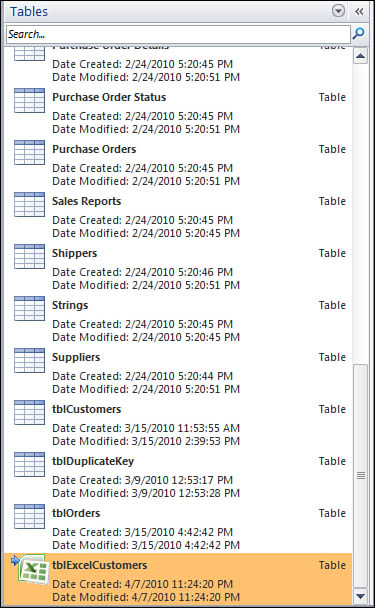Even if you’re not ready to actually import data
from a database management system (such as FoxPro), you still might
want to make changes to it by using Access. You can link to other types
of databases and to Excel spreadsheets.
Link to Excel Spreadsheets
Linking to Excel spreadsheets involves the following steps:
1. | Open the database that will contain the link.
|
2. | With
Tables selected as the object type, right-click in the Navigation Pane
and select Import and then Excel from the context menu. (Alternatively,
you can select Excel from the Import & Link group on the External
Data tab of the Ribbon.) The Get External Data – Excel Spreadsheet
dialog appears.
|
3. | Click Browse to locate the spreadsheet whose data you want to link to.
|
4. | Designate that you want to Link to the data source by creating a linked table.
|
5. | Click OK. The Link Spreadsheet Wizard appears.
|
6. | Select Show Worksheets or Show Named Ranges, as appropriate, and then click Next.
|
7. | Click to select First Row Contains Column Headings, if appropriate.
|
8. | Click Next.
|
9. | Type a name for the linked table.
|
10. | Click Finish, and then click OK. An icon associated with the linked table appears (see Figure 1).
|

Link to Other Databases
In addition to linking to Access tables and Excel
spreadsheets, you might want to link to dBASE, FoxPro, Paradox, and
other database files. Here are the required steps:
1. | Open the database that will contain the links.
|
2. | With
Tables selected in the object list, right-click in the Navigation Pane
and select Link Tables from the context menu. (Alternatively, you can
select the appropriate data type [for example, dBASE] from the More
drop-down in the Import & Link group on the External Data tab of
the Ribbon.)
|
3. | Click Browse and locate the file containing the data you want to link to.
|
4. | Select Link to the data source by creating a linked table.
|
5. | Click OK. The table appears in the Navigation Pane with the appropriate icon (for example, dBASE).
|
When working with linked tables in other databases, you need to remember a few important things, including the following:
When you link a table to the source, there
are some properties that you cannot change in the linked table. The
descriptions of these properties appear in red while in Design view of
the table.
Any data you change in a linked table changes in the source table, too.